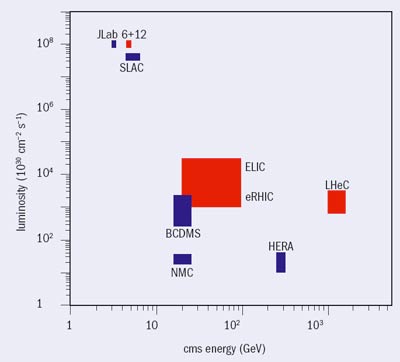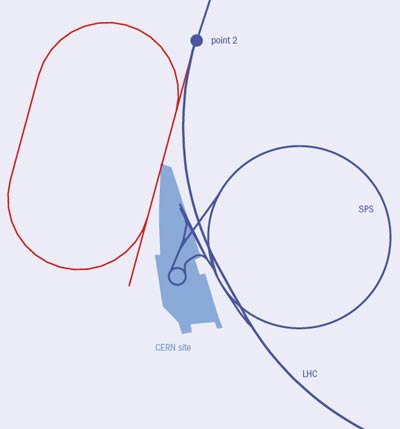A possible option to allow collisions with electrons at the LHC.

Abdus Salam, at the Rochester Conference in Tbilisi in 1976, considered the idea of “unconfined quarks” and leptons as a single form of matter, in contrast to the distinctions between them in the Standard Model. Some 30 years later, it is appropriate to ask if a high-performance electron–proton collider could be built to investigate such ideas, complementing the LHC and a pure lepton collider at the tera-electron-volt energy scale. Entering this unexplored territory for electron–quark scattering is a challenging prospect, but one that could yield vast rewards.
On 1–3 September 2008, some 90 physicists met at Divonne, near CERN, for the inaugural meeting of the ECFA–CERN Large Hadron Electron Collider (LHeC) workshop on electron–proton (ep) and electron–ion (eA) collisions at the LHC. The workshop will initially run for two years, and a diverse mixture of accelerator scientists, experimentalists and theorists will produce a conceptual-design report. This will assess the physics potential of an electron beam interacting with LHC protons and ions, as well as details of the electron–beam accelerator, the interaction region, detector requirements and the impact on the existing LHC programme. HERA, at DESY, was the previous ep machine at the energy frontier. By the time it ceased operation in 2007, its 15 year programme had led to many new insights into strong and electroweak interactions, provided much of the current knowledge of the parton densities of the proton and placed important constraints on physics beyond the Standard Model.
Physics potential
A new era of high energy and intensity for proton beams is now beginning with the switch-on of the LHC. Preliminary estimates suggest that the addition of an electron beam could yield ep collisions at a luminosity of the order of 1033 cm–2s–1 and a centre-of mass energy of 1.4 TeV (J Dainton et al. 2006). This would probe distance scales below 10–19 m (figure 1). In comparison, the best performance ever achieved at HERA was a luminosity of 5 × 1031 cm–2s–1 at an ep centre-of-mass energy of 318 GeV (figure 2).
The large luminosity and energy increases set the LHeC apart from other future ep colliders previously considered. If realized, it would lead to the first precise study of lepton–quark interactions at the tera-electron-volt scale and would have considerable discovery potential. The workshop in Divonne began with remarks from CERN’s chief scientific officer, Jos Engelen, who expressed CERN’s interest and support for the study. Encouragement from ECFA was sent via its chair, Karlheinz Meier of Heidelberg, and the involvement of the nuclear-physics community was highlighted by Guenther Rosner from Glasgow, now chair of the Nuclear Physics European Collaboration Committee (NuPECC). In his opening lecture, Guido Altarelli of Rome introduced the wide-ranging possibilities of ep physics at the “terascale” and urged that ep/eA collisions must happen at some point during the LHC’s lifetime. The chair of the LHeC steering group, Max Klein of Liverpool, then summarized previous promising work on the topic and the aims of the new workshop.
Following the opening session, the meeting split into smaller groups to discuss specialized issues in more detail, with each group reporting its findings at the conclusion of the meeting.

An LHeC would be uniquely sensitive to the physics of massive electron–quark bound states and to other exotic processes involving excited or supersymmetric fermions. Beyond the search for new particles such as these, the LHeC would complement the LHC in the investigation of the Standard Model and in understanding new physics. Light Higgs bosons would be produced dominantly through WW fusion and could be precisely studied in decay modes such as bb, which is expected to be problematic at the LHC. At the LHeC, top quarks would be produced copiously, both singly and in pairs, in the relatively clean environment offered by ep scattering.
With LHeC data the parton densities of the proton could be measured at momentum- transfer-squared beyond 106 GeV2 and at small fractions of the proton momentum (with Bjorken-x below 10–6), which are previously unexplored regions (figure 3). The kinematic range covered would match that required for a full understanding of parton–parton scattering in LHC proton–proton (pp) collisions. LHeC data would constrain each of the quark flavours separately for the first time, giving unrivalled sensitivity to the heavy quarks and to the gluon density over several orders of magnitude in x. In the process the strong coupling-constant could be measured to unprecedented precision.

Such an ep collider would provide an unrivalled laboratory for the study of strong-interaction dynamics. It would access a low-x region where quarks that are usually “asymptotically free” meet an extremely high background-density of partons. Various novel effects are predicted, including a well supported conjecture that, in protons at LHC energies, pairs of the densely packed partons begin to recombine into single quarks or gluons.
An LHeC would also allow for the scattering of leptons off heavy ions, which also has outstanding potential because all current knowledge of nuclear-parton distributions has been obtained in fixed-target experiments. The LHeC would extend the x and Q2 ranges explored by up to four orders of magnitude, offering an understanding of the initial partonic states in LHC heavy-ion collisions and amplifying the sensitivity to the new physics of ultradense partonic systems. Electron–deuteron scattering would allow the first exploration of neutron structure at collider energies, leading to further unique studies of parton densities and to tests of long-proposed relationships between diffraction and nuclear shadowing.
Accelerator challenges
To realize these wide-ranging physics possibilities the main challenge lies in bringing the LHC’s protons or heavy ions into collision at high luminosity with a new electron beam, without inhibiting the ongoing hadron–hadron collision experiments. Working groups are pursing two basic lay-outs of the electron accelerator for the conceptual design report, in order to understand fully the advantages and consequences of each.

An electron beampipe in the same tunnel as the LHC has the advantage of high luminosity, beyond 1033 cm–2s–1, at energies of 50–70 GeV for reasonable power consumption (figure 4). According to a preliminary study, synchronous ep and pp LHC operation appears to be possible. This set-up would require by-pass tunnels of several hundred metres around existing experiments. These ducts could be used to host the RF infrastructure and could be excavated in parallel with normal LHC operations. Injection to an electron ring could be provided by the Superconducting Proton Linac (SPL), which is under consideration as part of the LHC injection upgrade. A further option for an initial phase of the LHeC is to use multiple passes in the SPL for the full electron acceleration, which could produce energies of around 20 GeV.

An alternative solution for the electron beam is a linear accelerator (linac) with somewhat reduced luminosity but with an installation that is decoupled from the existing LHC ring (figure 5). The linac could use RF cavity technology under development for the proposed International Linear Collider, in either pulsed or continuous-wave mode. Power and cost permitting, it could produce energies of 100 GeV or more and provide electron–quark collisions at a centre-of-mass energy approaching 2 TeV.
Detailed calculations of the LHeC electron-beam optics have led to proposals for the layout of the interaction region, which is also a major consideration for the detector design. The highest projected luminosities, which are required to probe the hardest of ep collisions, may be achieved by placing beam-focusing magnets close to the interaction point. However, measurements at small angles to the beampipe are also important for the study of the densest partonic systems at low x and the hadronic final state at high x. Among the many interesting ideas, one proposed design involves instrumenting the focusing magnets for energy measurements. A first detector study for ep and eA physics at the LHeC includes high-precision tracking and high-resolution calorimetry, which would lead to a new level of precision in ep collider experiments.
Following an interim report presented to ECFA at the end of November 2008, the conceptual design work on an ep/eA collider at the LHC continues, with a second major workshop meeting scheduled for 7–8 September 2009. If realized, this facility would become an integral part of the quest to understand fully the new terascale physics that will emerge as the LHC era unfolds.





